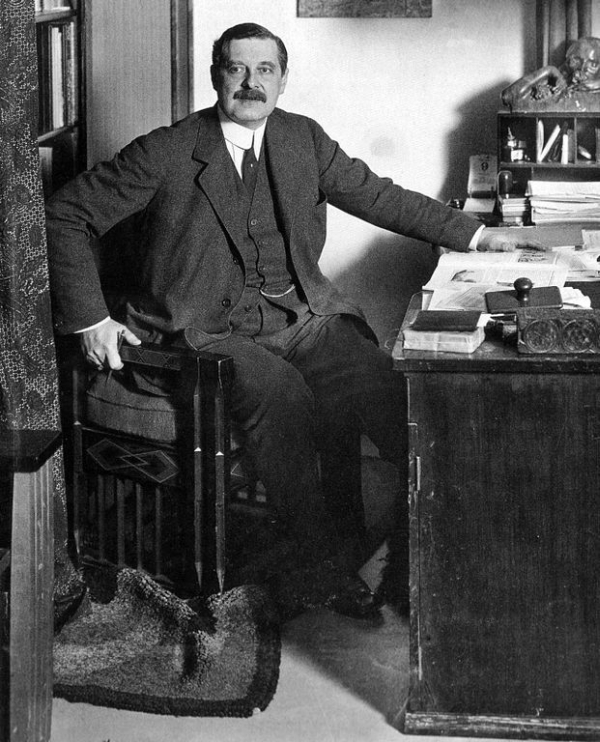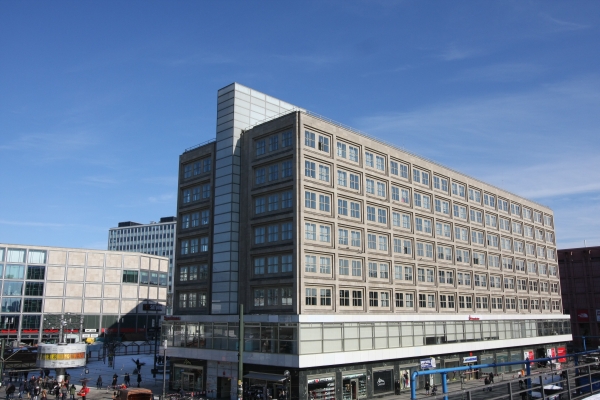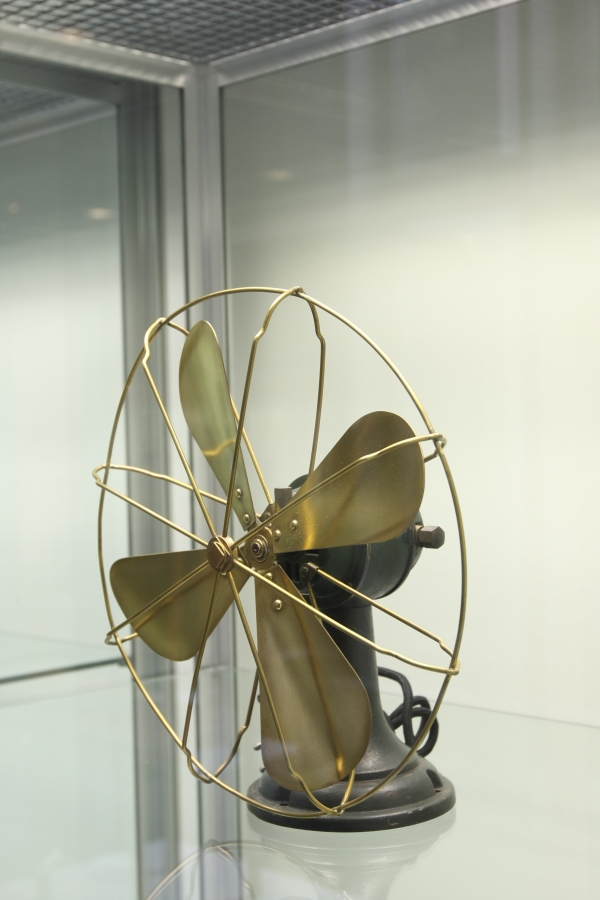NRW-Forum Düsseldorf present Peter Behrens und die Vielfalt der Gestaltung
By way of an addendum to our 5 New Design Exhibitions for March 2015 post, until March 28th the NRW-Forum Düsseldorf is presenting an exhibition devoted to the German artists, architect, designer and all round multi-talent, Peter Behrens.
Born in Hamburg on April 14th 1868 Peter Behrens was not just one of the earliest product designers and first proponents of corporate design but also played a decisive role in the development of European modernist architecture. Yet very much like his contemporary Henry van de Velde Behrens’ contribution to the development of European design and architecture is all too often reduced to a few buildings and moments in time.
Peter Behrens und die Vielfalt der Gestaltung at the NRW-Forum Düsseldorf aims to explain the man, his work and his influence in its full glory.
Initially trained as an artist in first Hamburg then Karlsruhe and Düsseldorf, Peter Behrens moved to Munich in 1892 where he established his own atelier and became a founding member of the Art Nouveau orientated Münchener Secession artists group before in 1897 he helped establish the Vereinigte Werkstätten für Kunst im Handwerk – United Workshops for Artistic Crafts – a company established by artists and architects who developed furniture and interior fittings in the progressive style of the day. Through the Vereinigte Werkstätten and the contact that enabled with leading protagonists such as Bruno Paul or Richard Riemerschmid, Peter Behrens’ interest in handicrafts and the combination of handicrafts with art grew and evolved, a process accelerated in 1899 when Peter Behrens was invited to join the so-called Mathildenhöhe Artists’ Colony in Darmstadt. Conceived as a location where artists could work and cooperate but also as a living exhibition of a new understanding of architecture, art, design and the relationship between the genres, the majority of the artists houses for the Mathildenhöhe estate were designed by the Austrian architect Joseph Maria Olbrich. Alone Peter Behrens designed his own house; his first architectural project and a building which was not only greatly admired by contemporary commentators but which despite its obvious Art Nouveau overtones expresses Behrens’ new thinking, or as Professor Stanford Anderson eloquently notes “Behrens’s faith in the formal power of line, manifest in his graphics, is here revealed in three dimensions” 1
Following a series of disputes over the direction Mathildenhöhe should go Peter Behrens left in 1903 to become Principle of the Kunstgewerbeschule Düsseldorf before in 1907 he was appointed “Artistic Advisor” with AEG in Berlin, at that time one of the world’s largest producers of electrical objects, both industrial and domestic.
Initially charged with re-styling the AEG Arc Lamp collection Peter Behrens quickly took over all artistic and aesthetic aspects of the AEG production, before ultimately taking on responsibility for architecture; a series of temporary exhibition pavilions being followed in 1909 by Peter Behrens’ first factory building for AEG, a turbine assembly hall in Berlin. Featuring a steel girder construction system the turbine assembly hall is not only notable for the way Behrens integrated the cranes into and with the structure but also the fact that what one assumes to be solid supporting concrete walls are in fact cladding without any structural function. In its day a genuine wonder of modern architecture the turbine hall not only helped Behrens move away from his image of an artist turned architect who could style without necessarily designing, but also helped usher in an understanding and acceptance of the new, progressive ideas in architecture thus allowing future developments. Following the success of the turbine assembly hall Peter Behrens went on to build further factory buildings and complexes for AEG, developed housing estates for AEG’s workers, boat houses for the company rowing clubs and even underground train stations.
In addition Peter Behrens developed a vast array of products for AEG, ranging from industrial switchboards over motors, clocks and kettles to ventilators of various sizes, created the interior design for the company showrooms and was responsible for developing the AEG corporate identity including packaging, logos and the company’s corporate communications, be that internal or external, and thus not only helped AEG, and by extrapolation Germany industry as a whole, adapt to the cultural, social and economic changes of the early 20th century but also developed the idea of a company as a brand.
Parallel and subsequent to his work with AEG Peter Behrens worked as a freelance architect, his most notable projects including the Mannesmann-Haus in Düsseldorf, the German Embassay in St Petersburg, Villa Wiegand in Berlin and the Technical Administration Building for the Hoechst AG in Frankfurt. Peter Behrens also contributed two houses for the 1927 Weißenhofsiedlung exhibition in Stuttgart
One of Peter Behrens’ final architecture projects was the so-called Alexanderhaus and Berolinahaus buildings on Berlin’s Alexanderplatz. Erected between 1929 and 1932 as part of a never fully realised new design concept for Alexanderplatz, the Behrens’ buildings remain to this day the only two competent and meaningful buildings on the site and in a sane and just world would serve as a compulsory guide and formal reference for others planning to build there.
And in that respect a particular highlight of Peter Behrens und die Vielfalt der Gestaltung promises to be the first public presentation of plans for Behrens’ never realised third Alexanderplatz building.
We’ve not seen the plans. But regardless, we say bin the Frank Gehry high-rise project, build the Peter Behrens’ work and do Berlin a big favour.
In addition to his architectural and design work Peter Behrens was one of the co-founders of the Deutscher Werkbund, taught at various leading European institutions, created the font used for the lettering “Dem Deutschen Volke” that to this day graces the façade of the Reichstag building in Berlin and was a direct, personal, influence on the generation of architects and designers who succeeded him.
Following his move to Berlin Peter Behrens set up his own architectural practice in a rented house/atelier in Potsdam-Babelsberg where he employed, amongst others, Walter Gropius and Ludwig Mies van der Rohe. The pair’s joint time with Behrens not only forging a lifelong relationship but also laying the groundwork for both men’s understanding of architecture, the role of architecture, the function of the product designer and for all the nature of the coming challenges, the changes industrialisation would bring and the need to develop new approaches to master them.
In addition, in 1910 the young Swiss architect Charles-Édouard Jeanneret-Gris a.k.a. Le Corbusier spent five months working in Behrens’ atelier as part of a study tour that would become his 1912 book, Étude sur le mouvement d’art décoratif en Allemagne – A Study of the Decorative Art Movement in Germany – one of the earliest explorations of the movement that would become “Modernism”, a text that greatly helped disseminate what was happening in Germany in the early 20th century and a work in which Le Corbusier describes Behrens as a “powerful, profound, serious genius, gripped by an urge to impose control; he is as if created for these tasks and for this time: most congenial to the spirit of present-day Germany.” And so five months that were to have a lasting impact on Le Corbusier.
An uncompromising advocate for a reduction in ornamentation and clear, uncluttered form language, so much so that he once had all the Gothic ornamentation removed from the façade of an existing AEG building, Peter Behrens wasn’t alone responsible for the transformation in architecture and design in the early 20th century; Peter Behrens’ contribution was however critical and in many ways understanding contemporary architecture and design requires an understanding of Peter Behrens and his oeuvre.
We’ve not seen Peter Behrens und die Vielfalt der Gestaltung, but any exhibition focusing on Peter Behrens is generally an exhibition well worth visiting.
Peter Behrens und die Vielfalt der Gestaltung runs at the NRW-Forum Düsseldorf, Ehrenhof 2, 40479 Düsseldorf until Saturday March 28th
Full details can be found at www.peter-behrens-ausstellung.de
1. Stanford Anderson, Peter Behrens and a New Architecture for the Twentieth Century, The MIT press, Cambridge, Massachusetts. 2000
Tagged with: Düsseldorf, NRW-Forum Düsseldorf, Peter Behrens, Peter Behrens und die Vielfalt der Gestaltung


